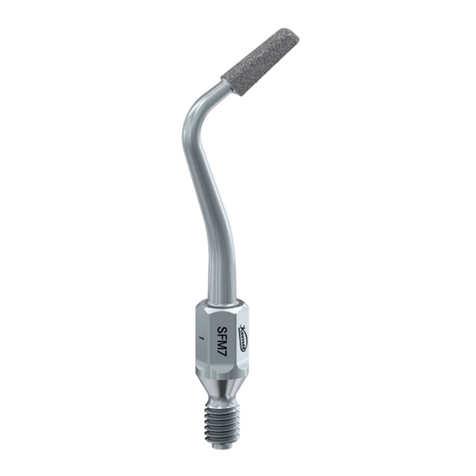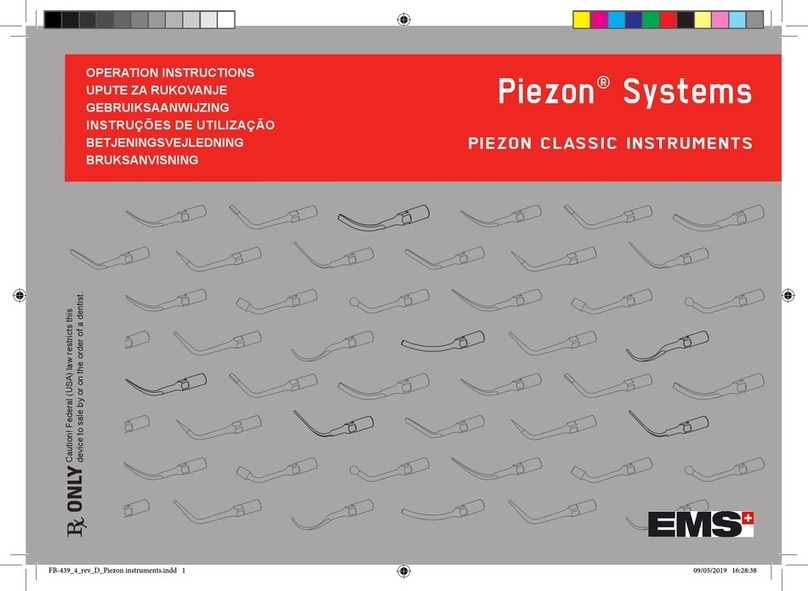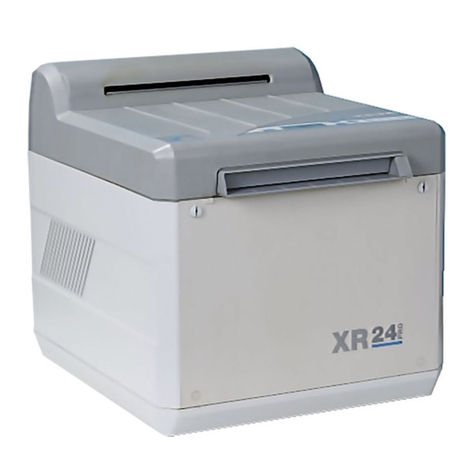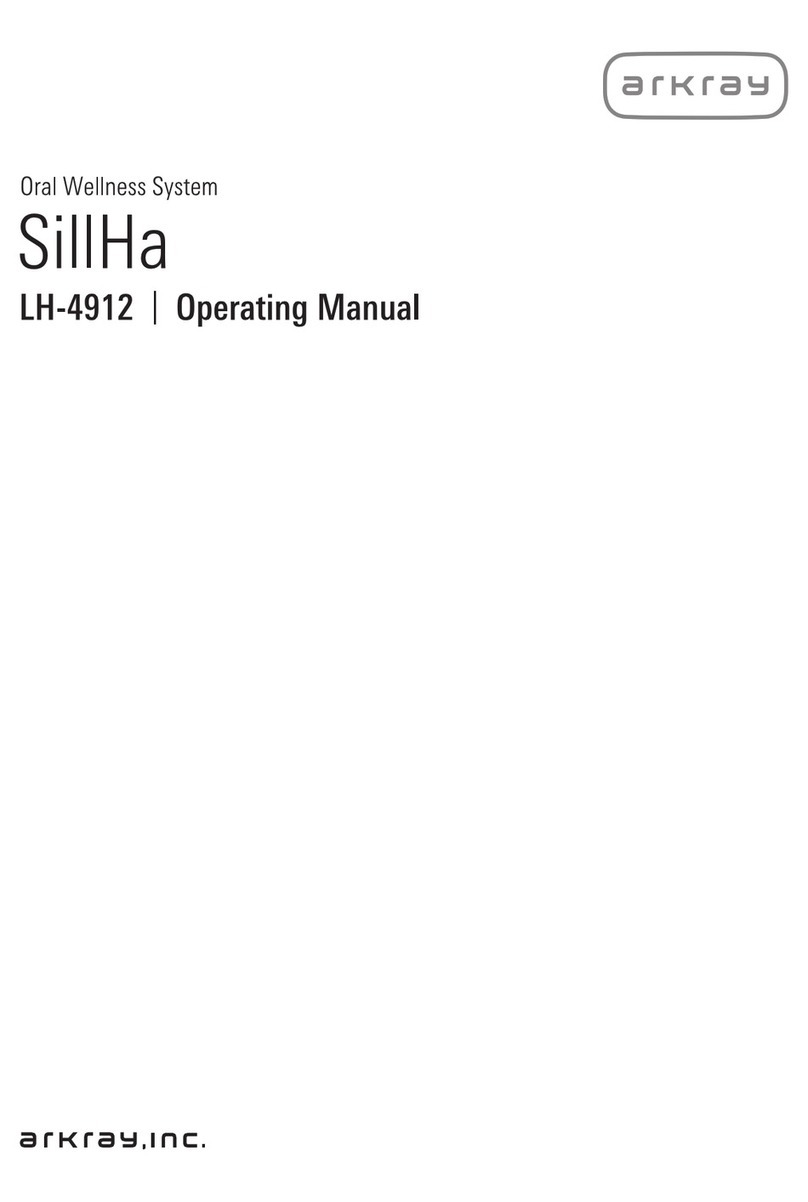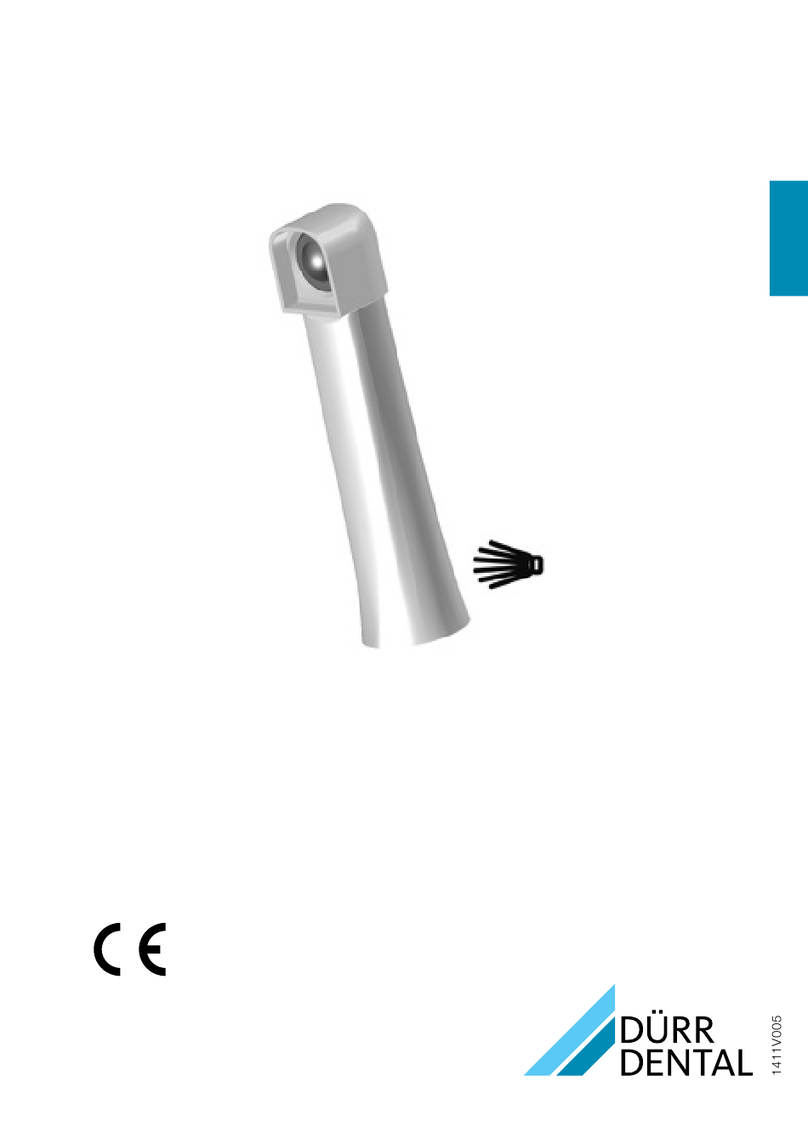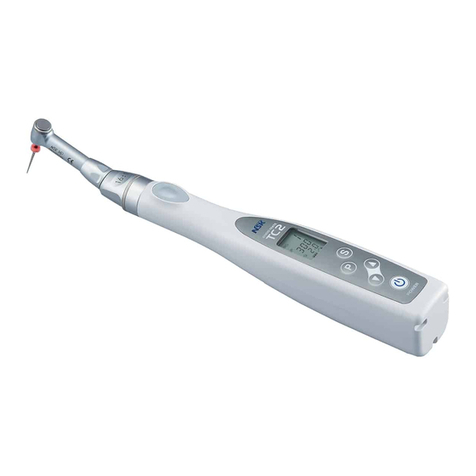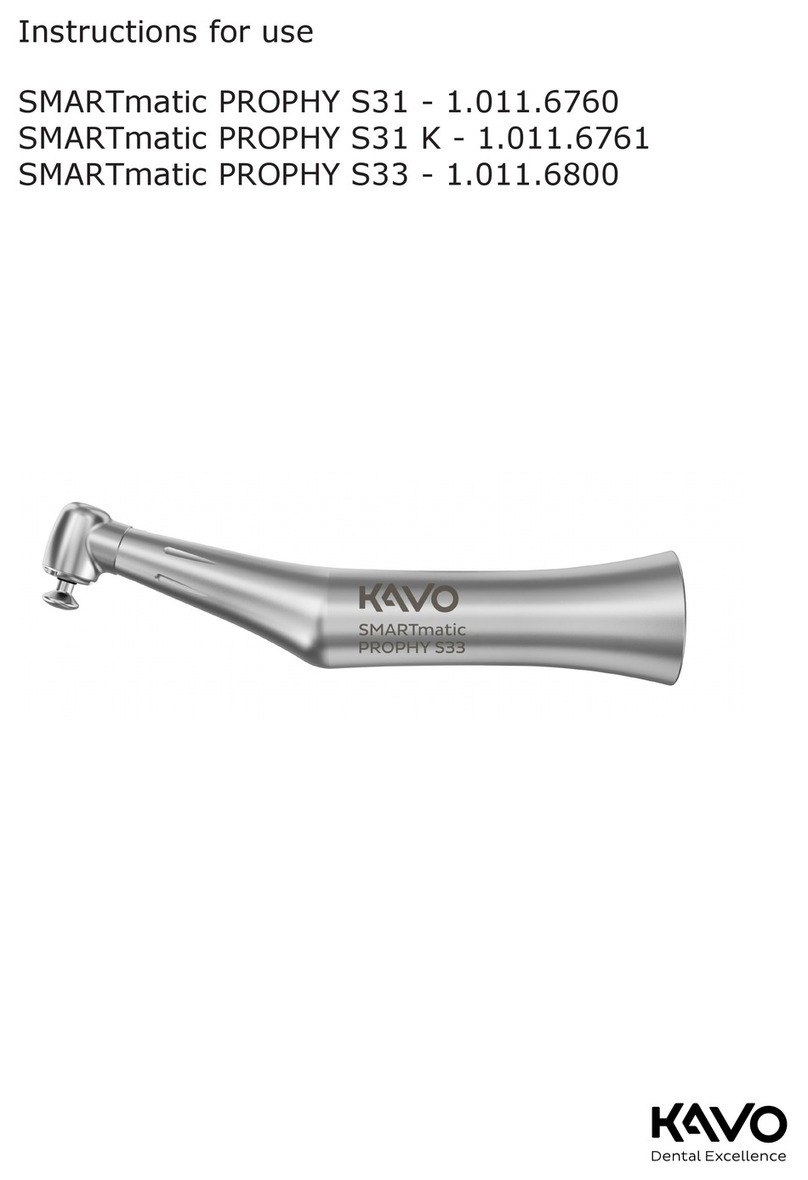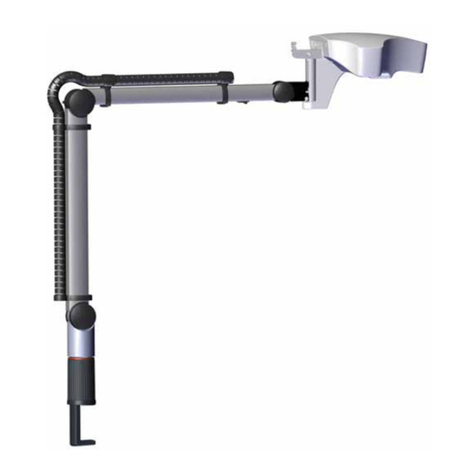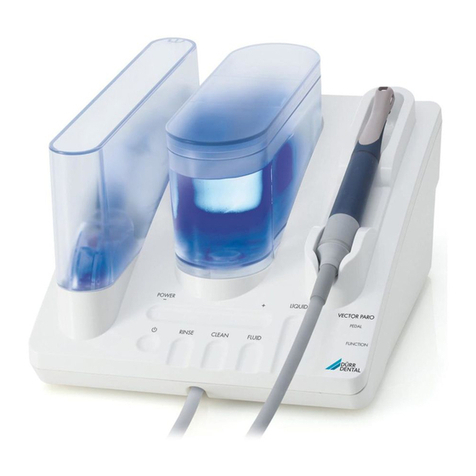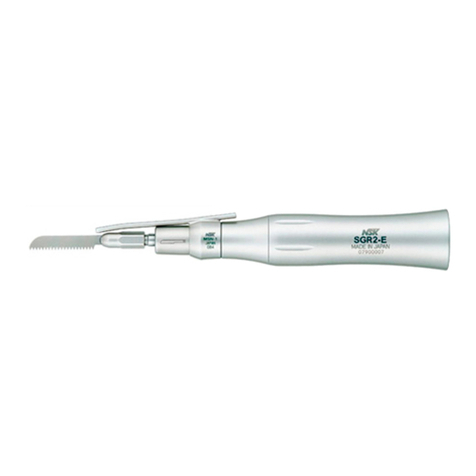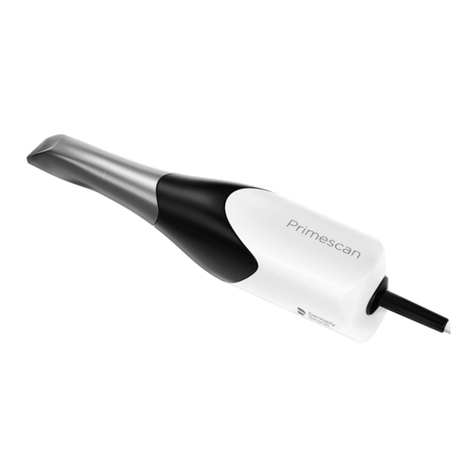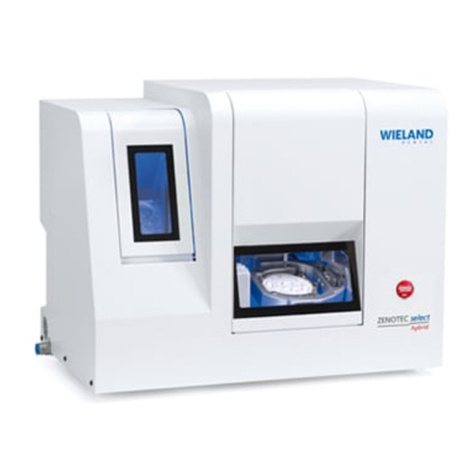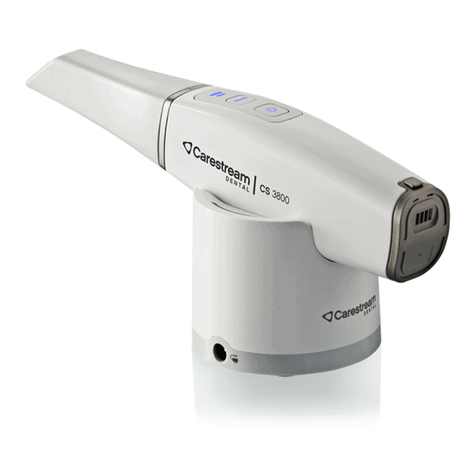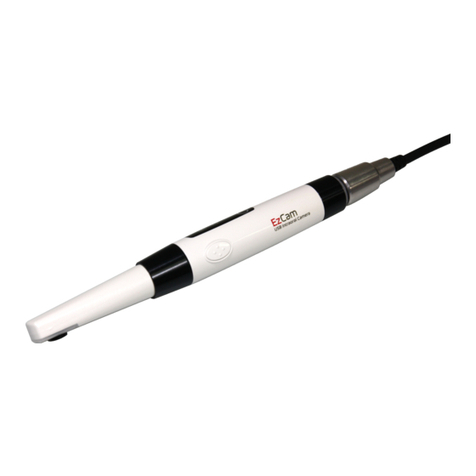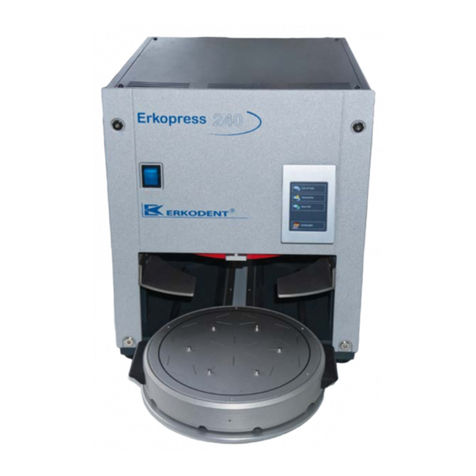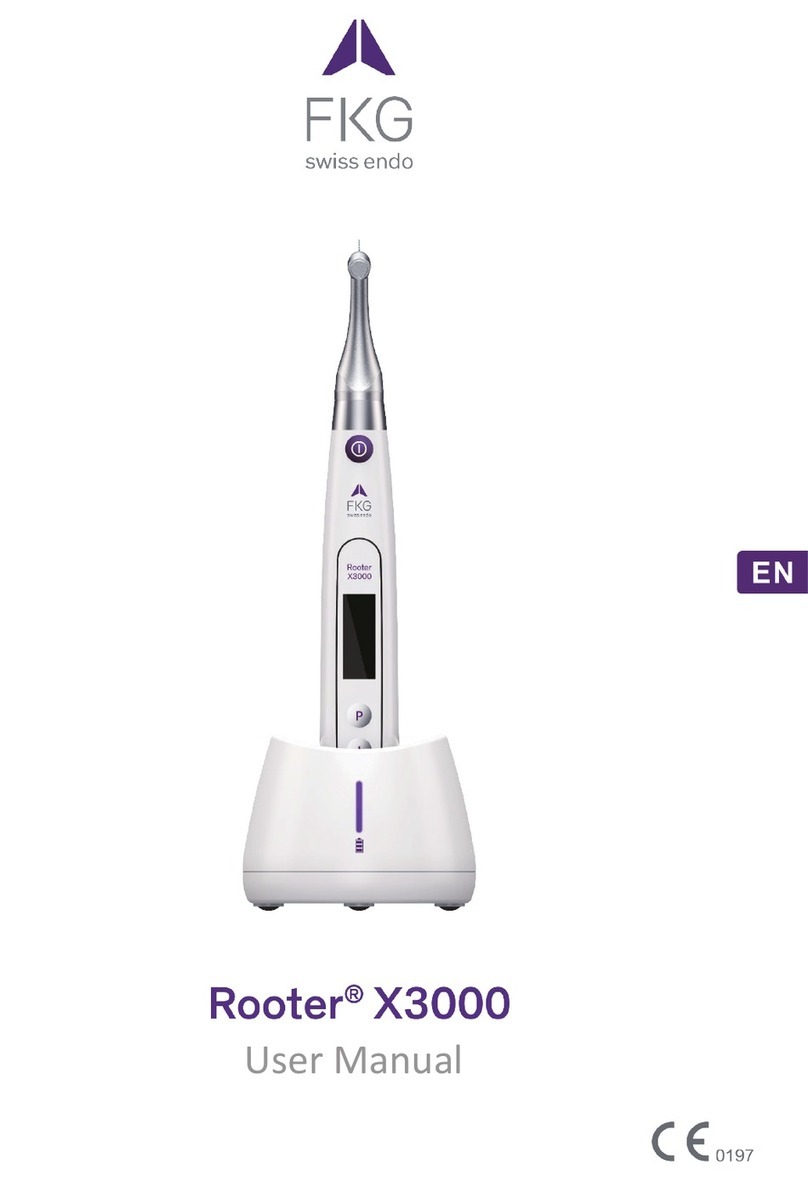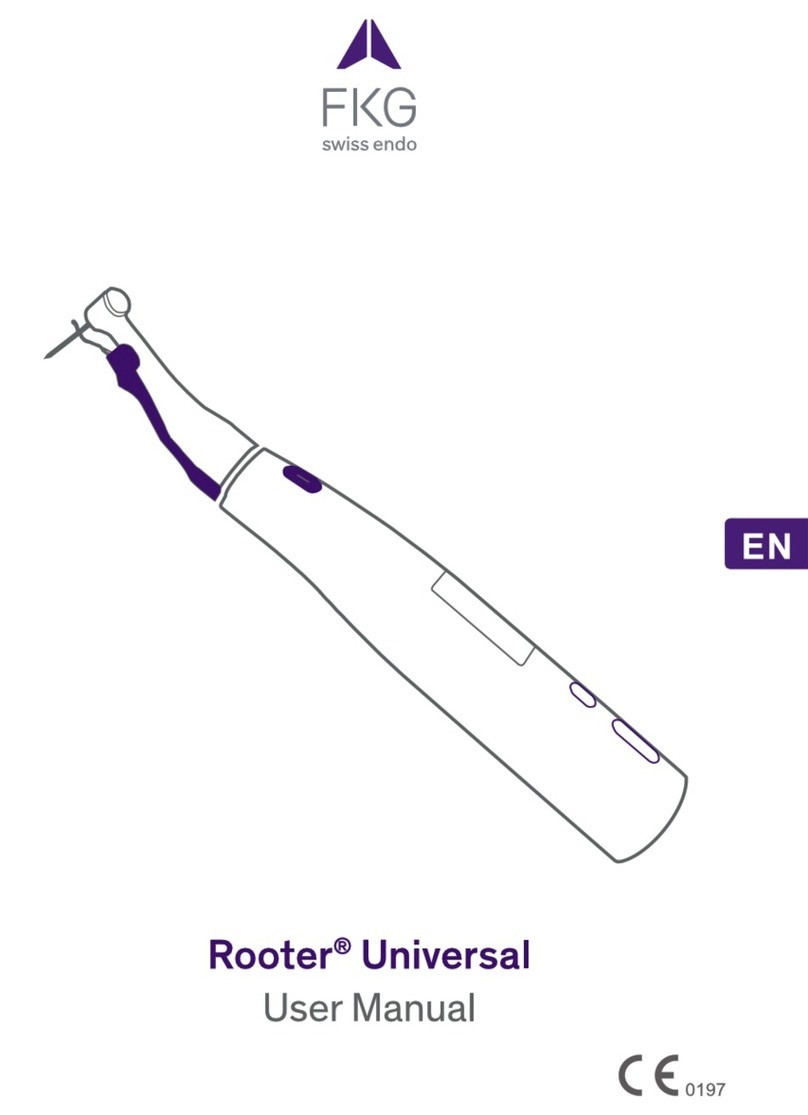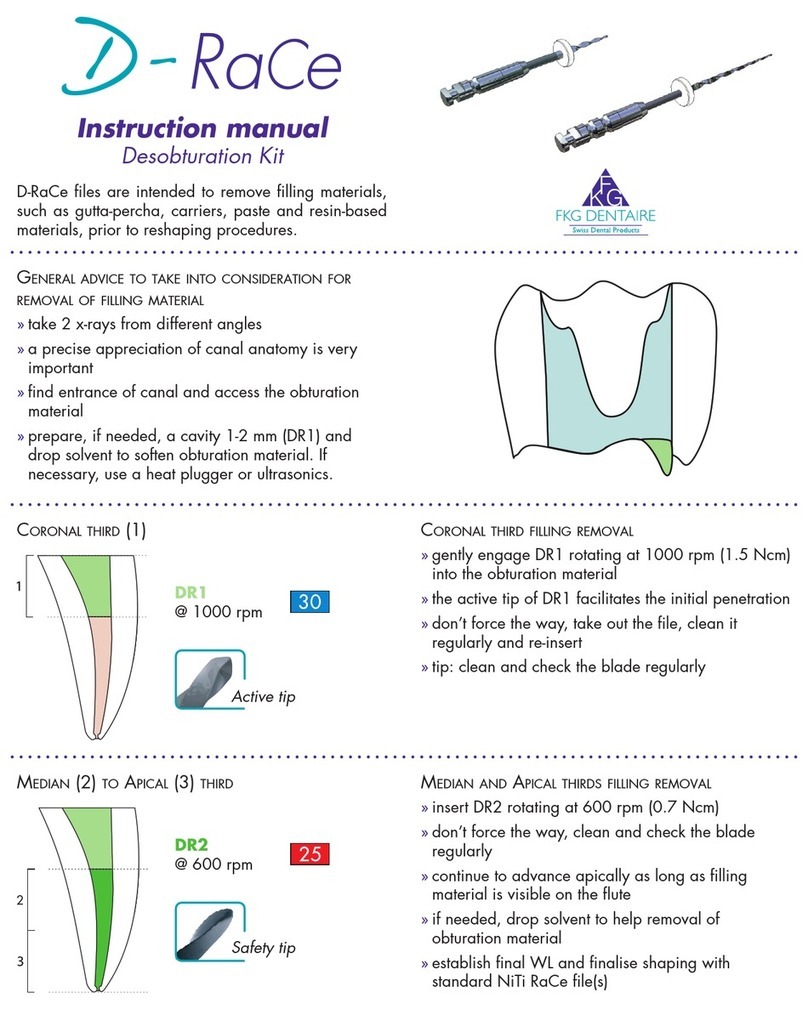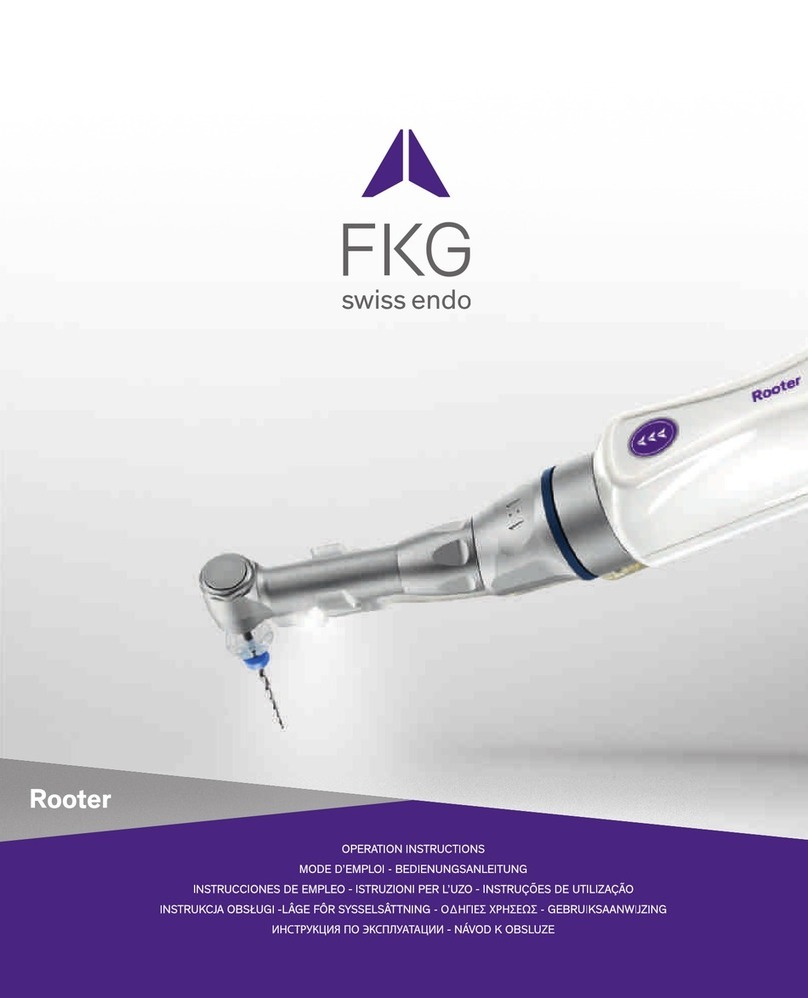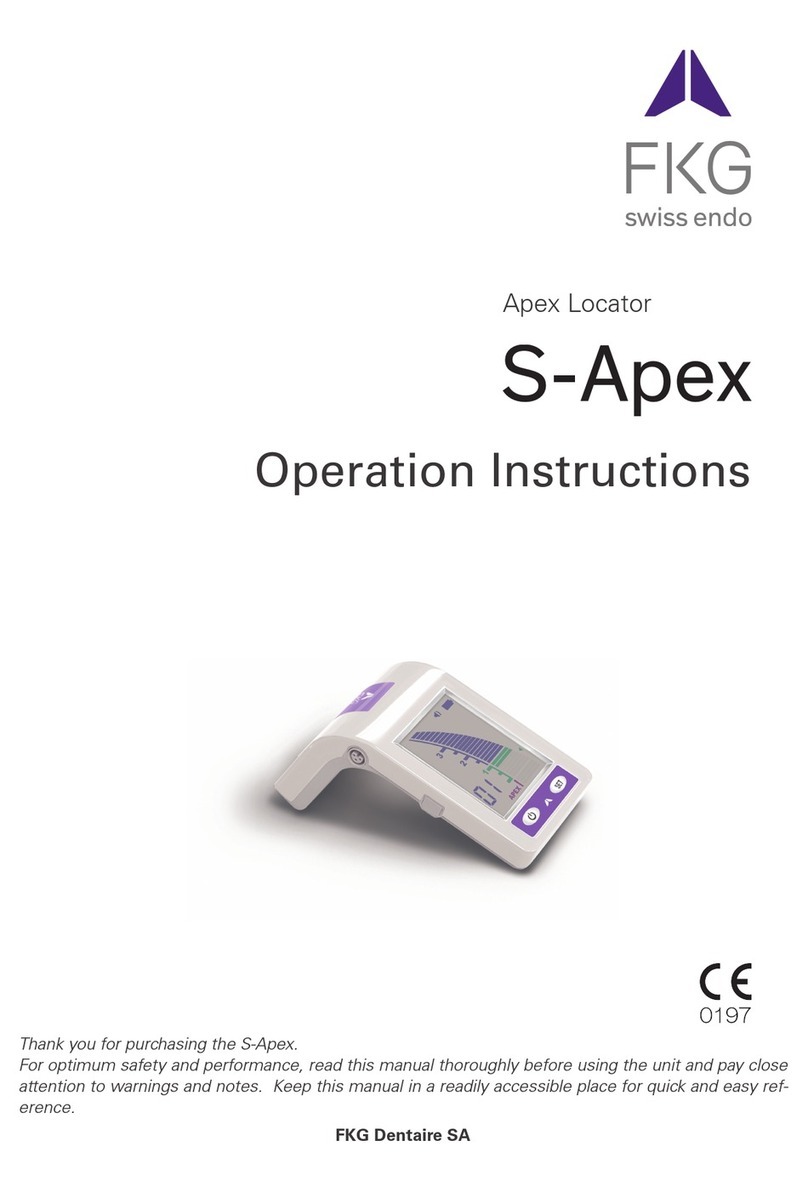
FKG Dentaire Sàrl
Le Crêt-du-Locle 4, 2322 Le Crêt-du-Locle, Switzerland
Tel. +41 32 924 22 44, info@fkg.ch, www.fkg.ch
FKG Dentaire Sàrl
Le Crêt-du-Locle 4, 2322 Le Crêt-du-Locle, Switzerland
1. Create straight-line coronal and radicular access.
2. Use an ISO010 hand file to explore the canal.
3. Determine the working length using a radiograph and/or an
apex locator.
4. Use the mechanised R-Motion® Glider instrument, applying
gentle strokes of 23 mm to establish a glide path until the
working length is reached. After 3strokes, remove and clean
the instrument, then irrigate; recapitulate with an ISO 010
handfile. Use of the R-Motion®Glider C is recommended for
canals which require an instrument with more rigidity, and/or
if the R-Motion®Glider is no longer progressing and can not
reach the working length.
5. Select the RMotion®single-file shaping instrument which is
best suited to the anatomy of the canal being treated. In most
cases, and depending on your approach to apical preparation,
the R-Motion®25 or R-Motion®30 will be appropriate. If the
radiographs do not allow you to clearly identify the anatomy of
the canal, it can be gauged using hand files.
6. Start the shaping procedure, applying your usual irrigation/
disinfection protocol.
7. Use gentle inward-outward movements of 23 mm, applying
very light apical pressure and allowing the instrument to
progress passively along the canal. After 3 strokes, remove
and clean the instrument, then irrigate; recapitulate with an
ISO010 hand file.
8. Repeat the previous step until the instrument has reached its
working length. If necessary, a brushing motion may be applied
to remove coronal interferences and/or ensure uniform shaping
of irregular canals. If the instrument is no longer progressing,
make one or more passes with the RMotion®20 instrument,
then resume using the RMotion®25 or the RMotion®30. Once
the working length has been reached, remove the instrument to
prevent over-enlargement of the foramen.
Once all the canals have been shaped, proceed with the cleaning
of the canals. For an optimal result, the use of XP-endo® Finisher
isrecommended.
Once the cleaning of the canals is completed, proceed to the next
phase of treatment:
9. Obturate with gutta-percha and sealer. TotalFill® BC Points™
and TotalFill®BC Sealer™ are recommended.
1. Créer un accès coronaire et radiculaire direct.
2. Utiliser une lime manuelle ISO010 afin d’explorer le canal.
3. Déterminer la longueur de travail à l’aide d’une radiographie
et/ou d’un localisateur d’apex.
4. Utiliser l’instrument mécanisé R-Motion® Glider à l’aide de
légers mouvements de va-et-vient de 23 mm pour établir
un glide path jusqu’à atteindre la longueur de travail. Après
3 mouvements de va-et-vient, retirer et nettoyer l’instrument,
puis irriguer; récapituler avec une lime manuelle ISO 010.
L’utilisation du R-Motion®Glider C est recommandée pour les
canaux demandant une rigidité accrue de l’instrument et/ou si le
R-Motion®Glider ne progresse plus et n’arrive pas à atteindre
la longueur de travail.
5. Sélectionner l’instrument unique de mise en forme RMotion
®
s’adaptant au mieux à l’anatomie du canal traité. Dans la
plupart des cas, et selon votre approche de préparation
apicale, le R-Motion
®
25 ou le R-Motion
®
30 conviendra. Si
lesradiographies nevous permettent pas une identification claire
de l’anatomie du canal, jauger celle-ci à l’aide de limes manuelles.
6. Initier la procédure de mise en forme en suivant votre protocole
d’irrigation/désinfection habituel.
7. Utiliser de légers mouvements de va-et-vient de 23 mm
avec une pression apicale très faible et laisser l’instrument
progresser de manière passive le long du canal. Après
3 mouvements de va-et-vient, retirer et nettoyer l’instrument,
puis irriguer; récapituler avec une lime manuelle ISO010.
8. Répéter l’étape précédente jusqu’à mener l’instrument à la
longueur de travail. Si nécessaire, un mouvement de brossage
peut être appliqué afin de supprimer les interférences coronaires
et/ou uniformiser la mise en forme des canaux irréguliers.
Si l’instrument ne progresse plus, effectuer un ou plusieurs
passages avec l’instrument RMotion®20, puis réutiliser le
RMotion®25 ou le RMotion®30. Une fois la longueur de travail
atteinte, retirer l’instrument pour éviter un agrandissement
excédentaire du foramen.
Une fois la mise en forme des canaux terminée, procéder au
nettoyage des canaux. Pour un résultat optimal, l’utilisation de
XP-endo®Finisher est recommandée.
Une fois le nettoyage des canaux terminé, procéder à la phase
suivante du traitement:
9. Obturer avec de la gutta-percha et du ciment.
TotalFill®BCPoints™etTotalFill®BC Sealer™sont recommandés.
1. Einen geradlinigen koronalen und radikulären Zugang präparieren.
2. Den Kanal mit einer Handfeile ISO010 sondieren.
3. Die Arbeitslänge mit einer Röntgenaufnahme und/oder einem
Apexlokalisator bestimmen.
4. Mit dem mechanischen Instrument R-Motion® Glider mit
sanften Ein- und Auswärtsbewegungen von 2
–
3 mm einen
Gleitpfad bis zur Arbeitslänge erstellen. Nach drei Hin- und
Herbewegungen das Instrument entfernen und reinigen,
dann spülen; mit einer Handfeile ISO 010 rekapitulieren.
Die Verwendung des R-Motion®Glider C wird für Kanäle
empfohlen, die eine erhöhte Steifigkeit des Instruments
erfordern und/oder wenn der R-Motion®Glider nicht weiter
vordringt und die Arbeitslänge nicht erreicht werden kann.
5. Das RMotion®Aufbereitungsinstrument, das der Anatomie
des zu behandelnden Kanals am besten entspricht, wählen.
In den meisten Fällen und je nach Vorgehensweise bei der
apikalen Aufbereitung ist R-Motion® 25 oder R-Motion® 30
geeignet. Wenn die Anatomie des Kanals anhand der
Röntgenaufnahmen nicht eindeutig bestimmt werden kann,
dieAnatomie mithilfe von Handfeilen bestimmen.
6. Die Aufbereitung unter Einhaltung Ihres üblichen Spül-/
Desinfektionsprotokolls beginnen.
7. Mit sehr wenig Druck nach apikal sanfte Ein- und
Auswärtsbewegungen von 23 mm ausführen und das
Instrument passiv in den Kanal eindringen lassen. Nach drei
Ein- und Auswärtsbewegungen das Instrument entfernen und
reinigen, dann spülen; mit einer Handfeile ISO010 rekapitulieren.
8. Den vorherigen Schritt wiederholen, bis das Instrument
die Arbeitslänge erreicht hat. Gegebenenfalls kann eine
Bürstbewegung vorgenommen werden, um koronale
Interferenzen zu beseitigen und/oder um unregelmäßige
Kanäle gleichmäßig aufzubereiten. Wenn das Instrument
nicht weiter vordringt, einen oder zwei Durchgänge mit dem
RInstrument Motion®20 durchführen und anschließend wieder
das Instrument RMotion®25 oder RMotion®30 verwenden.
Wenn die Arbeitslänge erreicht ist, das Instrument entfernen,
um eine übermäßige Vergrößerung des Foramen zu vermeiden.
Wenn die Aufbereitung der Kanäle abgeschlossen ist, fahren Sie
mit der Reinigung der Kanäle fort. Für optimale Ergebnisse wird die
Verwendung von XP-endo®Finisher empfohlen.
Wenn die Reinigung aller Kanäle abgeschlossen ist, fahren Sie mit
der nächsten Phase der Behandlung fort:
9. Mit Guttapercha und Sealer füllen. Wir empfehlen
TotalFill®BCPoints™ und TotalFill®BCSealer™.
Protocol for use Protocole d’utilisation Anwendungsprotokoll
Symbols / Symboles /Symbole
Expiry date
Date de péremption
Verfallsdatum
Single use (max. 4 canals)
Usage unique (max. 4 canaux)
Einmalgebrauch (Max. 4 Kanäle)
Do not use if package is damaged
Ne pas utiliser si l’emballage est endommagé
Bei beschädigter Verpackung nicht verwenden
Sterilized product (irradiation)
Produit stérile (irradiation)
Steriles Produkt (Bestrahlung)
Reciprocating motion (counterclockwise)
Mouvement de réciprocité (antihoraire)
Reziproke Bewegung (gegen den Uhrzeigersinn)
Nickel-Titanium instrument
Instrument en Nickel-Titane
Nickel-Titan-Instrument
Warning: refer to the user manual
Attention: consulter la notice d’utilisation
Warnung: Gebrauchsanleitung beachten
Reference number
Numéro de référence
Referenznummer
Batch number
Numéro de lot
Chargenbezeichnung
Manufacturer
Fabricant
Hersteller


